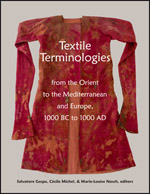Centre for Textile Research
Date of this Version
2017
Document Type
Article
Citation
In Textile Terminologies from the Orient to the Mediterranean and Europe, 1000 BC to 1000 AD, ed. Salvatore Gaspa, Cécile Michel, & Marie-Louise Nosch (Lincoln, NE: Zea Books, 2017), pp. 528-537
doi:10.13014/K23X84TR
Abstract
Since February 2015, the digital dictionary or term database, textilnet.dk, has been accessible on the Internet.1 The purpose of this paper is to present the background and methods of this pilot project. Since 2010, the project has collaborated with The Danish National Research Foundation’s Centre for Textile Research (CTR), University of Copenhagen, and has gained moral support from Sabine Kirchmeier-Andersen, director of Dansk Sprognævn, the Danish National Language Advisory Committee.2 From 2011 to 2015, we have been working with generous funding from the Danish Ministry of Culture. The objective of textilnet.dk is to preserve and communicate the cultural heritage of words and expressions for clothing and textiles in the Danish language. The unique starting points of the project include the collections of handwritten and typewritten files of terms compiled by the Danish textile researchers Erna Lorenzen and Ellen Andersen, quotations from all types of literature from textile conservator Else Østergård, and photographic slides of 1980s textile samples by textile scholar and ethnologist Ingeborg Cock-Clausen, which provide great illustrative assistance.
The files of Erna Lorenzen and Ellen Andersen: Dr Erna Lorenzen (1909-2006)3 was the keeper and curator of the collection of historical dress and textiles in Den Gamle By (The Old Town), Danish Open Air Museum of Urban History and Culture4 from 1959 to 1979. After she passed away in 2006, her files, which were probably collected while she was researching for her doctoral thesis, Folks Tøj i og omkring Aarhus ca. 1675 - ca. 1850, were found and brought to Den Gamle By. These files have proved to be a true treasure chest for anyone interested in the terminology of different fabrics and textile fibres. Around 900 index cards with words have been thoroughly researched and digitized for textilnet.dk.
From 1936 to 1966, Ellen Andersen (1898-1989)7 was the keeper and curator at the National Museum of Denmark,8 and, like Erna Lorenzen, had special responsibility for historical dress and textiles. Ellen Andersen’s files are kept in the National Museum of Denmark, and her collection is larger (approximately 5,000 index cards) and more diverse than Erna Lorenzen’s. Apart from terms for dress and textiles, Ellen Andersen’s files contain many index cards with references to literature and other sources, which describe items kept in the National Museum. The index cards, which are not strictly about the definition of concepts, are keyed into Word documents as part of the textilnet.dk project but are not currently released in the online version of the database. There is, however, great potential which will hopefully be made available later. The majority of terms for fibres and fabrics in Ellen Andersen’s collections are identical with Lorenzen’s but Andersen’s also focuses on terms for dress and parts of clothing. These number about 150 index cards, which are typed into Word files and made available as quotations in textilnet.dk.
Included in
Ancient History, Greek and Roman through Late Antiquity Commons, Art and Materials Conservation Commons, Classical Archaeology and Art History Commons, Classical Literature and Philology Commons, Fiber, Textile, and Weaving Arts Commons, Indo-European Linguistics and Philology Commons, Jewish Studies Commons, Museum Studies Commons, Near Eastern Languages and Societies Commons, Other History of Art, Architecture, and Archaeology Commons


Comments
Copyright © 2017 Salvatore Gaspa, Cécile Michel, & Marie-Louise Nosch. Photographs copyright as noted.